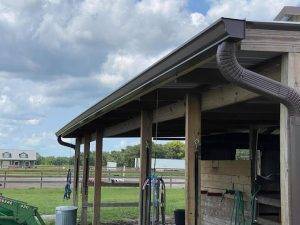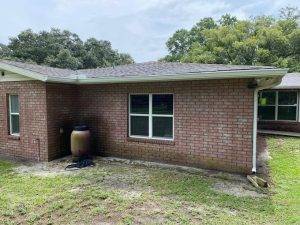Gutter installation is a crucial aspect of home maintenance that ensures proper water drainage and protects your property from water damage. Whether you’re a DIY enthusiast or considering hiring a professional, understanding the process and its benefits is essential. In this comprehensive guide, we’ll delve into everything you need to know about gutter installation, from types and materials to step-by-step instructions and maintenance tips.
Understanding Gutters
Types of Gutters
There are various types of gutters to choose from, each with its unique features and benefits. K-style gutters, named for their resemblance to the letter ‘K’ when viewed from the side, are popular for their decorative look and efficiency. Half-round gutters, as the name suggests, are semicircular and often found in older homes due to their classic appearance. Box gutters are built into the roof and are ideal for commercial buildings or homes with a flat roof.
Materials Used in Gutters
Gutters come in different materials, each offering distinct advantages. Aluminum gutters are lightweight, rust-resistant, and affordable, making them a popular choice. Copper gutters, while more expensive, offer durability and a unique aesthetic as they develop a patina over time. Vinyl gutters are budget-friendly and easy to install but may not be as durable as metal options.
Function of Gutters
The primary function of gutters is to direct rainwater away from your home, preventing soil erosion, foundation damage, and flooding. Properly installed gutters protect your landscaping and prevent water from seeping into your basement or crawl spaces. They also help maintain the integrity of your home’s exterior by preventing water damage to siding and windows.
Preparing for Gutter Installation
Assessing Your Home’s Needs
Before you begin gutter installation, it’s crucial to assess your home’s needs. Start by analyzing your roof structure to determine the best gutter type and size. Measure the roof perimeter to calculate the required length of gutters and downspouts. Identify water flow patterns to ensure optimal placement of gutters and downspouts for efficient drainage.
Choosing the Right Gutters
Selecting the right gutters involves considering several factors. The material you choose should balance durability, aesthetics, and cost. Aluminum, copper, and vinyl each have their pros and cons. The gutter size should accommodate the average rainfall in your area. Finally, consider the aesthetics of your home and choose a gutter style that complements its design.
Tools and Materials Needed
Having the right tools and materials is essential for a successful gutter installation. Essential tools include a ladder, measuring tape, level, hacksaw, and drill. Safety equipment such as gloves and safety glasses is crucial to protect yourself during installation. Additional materials include gutter sections, hangers, downspouts, sealant, and screws.
Step-by-Step Gutter Installation Guide
Planning the Layout
Effective gutter installation starts with a well-thought-out layout plan. Begin by marking downspout locations to ensure proper water drainage. Determine the slope needed for the gutters to facilitate water flow; a slight slope is sufficient. Create a detailed plan that outlines the position of gutters, downspouts, and hangers.
Installing Gutter Hangers
Gutter hangers provide support and ensure that gutters stay in place. Choose the appropriate hanger type for your gutters and space them according to the manufacturer’s recommendations. Secure the hangers firmly to the fascia board to provide adequate support and prevent sagging over time.
Attaching the Gutters
Once the hangers are in place, it’s time to attach the gutters. Measure and cut the gutter sections to the required lengths. Connect the sections using connectors or sealant to ensure watertight joints. Secure the gutters to the hangers, making sure they are level and properly aligned with the slope.
Adding Downspouts
Choosing Downspout Locations
Choosing the right locations for downspouts is crucial for effective water drainage. Place downspouts at strategic points where water can be directed away from the foundation. Avoid obstacles such as windows and doors. Proper placement ensures efficient drainage and prevents water from pooling around your home.
Installing Downspout Brackets
Downspout brackets provide support and keep downspouts securely attached to the wall. Space the brackets evenly along the length of the downspout. Secure the brackets firmly to the wall using screws or anchors. Preparing for downspout attachment ensures a stable and durable installation.
Connecting Downspouts
Measure and cut the downspouts to the required lengths. Attach elbows and extensions to direct water away from the foundation. Secure the downspouts to the brackets using screws or rivets. Properly connected downspouts ensure efficient water flow and prevent leaks.
Sealing and Testing the System
Sealing Gutter Joints
Sealing gutter joints is essential to prevent leaks. Choose a high-quality sealant designed for gutters. Apply the sealant generously to all joints and connections. Ensure the sealant is evenly spread and creates a watertight bond to keep your gutters leak-free.
Inspecting for Leaks
After sealing the joints, inspect the gutters for any signs of leaks. Perform a visual inspection to check for gaps or cracks. Test the system by running water through the gutters and downspouts. Identifying and fixing leaks early prevents water damage to your home.
Final Adjustments
Make any necessary final adjustments to ensure the gutters are properly aligned and sloped. Check the overall stability and secure any loose sections. Conduct a final walkthrough to verify that the gutter system functions correctly and effectively.
Maintenance Tips for Long-lasting Gutters
Regular Cleaning
Regular cleaning is essential to maintain the efficiency of your gutters. Clean the gutters at least twice a year, more frequently if you have overhanging trees. Use a gutter scoop or garden trowel to remove debris. Ensure your safety by using a sturdy ladder and wearing gloves.
Inspecting for Damage
Regularly inspect your gutters for signs of damage. Look for cracks, holes, or sagging sections. Address minor issues promptly to prevent them from escalating into more significant problems. Professional inspection can help identify hidden issues and ensure thorough maintenance.
Preventative Measures
Implementing preventative measures can extend the lifespan of your gutters. Install gutter guards to keep debris out and reduce cleaning frequency. Trim nearby trees to prevent leaves and branches from clogging the gutters. Establish a regular maintenance schedule to keep your gutters in top condition.
Benefits of Professional Gutter Installation
Expertise and Experience
Hiring professionals for gutter installation brings expertise and experience to the table. Professionals have the knowledge to handle complex installations and avoid common mistakes. Their experience ensures that your gutters are installed correctly and efficiently.
Quality of Workmanship
Professional gutter installers use superior materials and pay attention to detail. This results in a high-quality installation that stands the test of time. The workmanship of professionals ensures that your gutters are durable and function effectively.
Warranty and Support
Professional gutter installation often comes with warranty and support services. Warranties provide coverage for potential issues, giving you peace of mind. Ongoing support services ensure that any problems are addressed promptly and efficiently.
DIY Gutter Installation vs. Hiring Professionals
Cost Comparison
Cost is a significant factor when deciding between DIY gutter installation and hiring professionals. DIY projects may save money on labor, but material costs and potential mistakes can add up. Professional installation may have higher upfront costs but can be more cost-efficient in the long run due to quality and durability.
Time and Effort
DIY gutter installation requires a significant time commitment and effort. Professionals complete the job efficiently, saving you time and hassle. Consider your availability and skills when deciding between DIY and professional installation.
Potential Risks
DIY gutter installation comes with potential risks such as safety concerns and installation errors. Professionals have the expertise to handle these risks effectively. Incorrect installation can lead to long-term consequences and costly repairs.
Common Gutter Installation Mistakes
Incorrect Slope
Incorrect slope is a common gutter installation mistake that can hinder water flow. An improper slope can cause water to pool in the gutters, leading to overflows and leaks. Measure the slope accurately and adjust it to ensure efficient drainage.
Insufficient Support
Inadequate support is another common mistake in gutter installation. Proper spacing of hangers is crucial to prevent sagging and ensure stability. Signs of insufficient support include sagging gutters and loose sections. Strengthen the system by adding more hangers and ensuring secure attachment.
Ignoring Local Codes
Ignoring local building codes can lead to problems with gutter installation. Building codes are in place to ensure safety and proper function. Research and comply with local regulations to avoid fines and ensure a successful installation.
Enhancing Gutter System Efficiency
Gutter Guards
Gutter guards are an effective way to enhance gutter system efficiency. They prevent debris from entering the gutters, reducing the need for frequent cleaning. Install gutter guards to maintain unobstructed water flow and prolong the lifespan of your gutters.
Rain Chains
Rain chains offer both functional and aesthetic benefits. They guide water from the gutters to the ground in a visually appealing manner. Install rain chains to add a decorative touch to your home while ensuring effective water drainage.
Rain Barrels
Rain barrels are a sustainable option for enhancing gutter system efficiency. They collect rainwater from the gutters, which can be used for gardening and other purposes. Connect rain barrels to your gutter system to conserve water and reduce runoff.
Troubleshooting Gutter Issues
Common Problems
Gutters can encounter common problems such as clogs, leaks, and sagging. Clogs and blockages prevent water from flowing freely, leading to overflows. Leaks and holes can cause water damage to your home. Sagging gutters indicate insufficient support.
Quick Fixes
Address gutter issues promptly with quick fixes. Clear clogs using a gutter scoop or garden hose. Patch leaks with gutter sealant or repair tape. Reinforce sagging sections by adding additional hangers or supports.
When to Call a Professional
Some gutter issues require professional intervention. Persistent clogs, major leaks, and significant sagging are signs that you need expert help. Professionals have the tools and expertise to address these issues effectively and ensure long-term solutions.
The Environmental Impact of Gutters
Preventing Soil Erosion
Gutters play a crucial role in preventing soil erosion. They direct rainwater away from your home, preventing it from washing away soil and landscaping. Properly installed gutters protect the environment by maintaining soil integrity.
Protecting Home Foundation
Gutters protect your home’s foundation by directing water away from the base. Water that pools around the foundation can cause cracks and structural damage. Effective gutter installation ensures that your foundation remains stable and secure.
Sustainable Gutter Materials
Choosing sustainable gutter materials can reduce your environmental footprint. Eco-friendly options such as aluminum and copper are durable and recyclable. Selecting sustainable materials contributes to environmental conservation and long-term sustainability.
Gutter Installation Costs
Factors Affecting Costs
Several factors affect the cost of gutter installation. The material you choose, the size and design of your home, and labor costs all play a role. Understanding these factors helps you budget effectively for your gutter installation project.
Budgeting for Installation
Budgeting for gutter installation involves estimating costs and planning accordingly. Consider the average cost of materials and labor in your area. Explore cost-saving tips such as DIY installation or purchasing materials in bulk. Financing options can help manage the expense.
Getting Quotes from Professionals
Obtaining quotes from professionals is an essential step in the gutter installation process. Research and find reliable contractors with positive reviews. Compare quotes to find the best value for your money. Ask questions to ensure you understand the scope of work and what’s included in the price.
FAQs About Gutter Installation
1. How often should gutters be cleaned?
Gutters should be cleaned at least twice a year, ideally in the spring and fall, to prevent clogs and ensure proper water flow.
2. What is the best material for gutters?
The best material depends on your budget, climate, and aesthetic preferences. Aluminum is a popular choice for its balance of durability and cost.
3. Can I install gutters myself?
Yes, with the right tools and knowledge, you can install gutters yourself. However, professional installation ensures accuracy and long-term reliability.
4. How do I know if my gutters need replacement?
Signs that gutters need replacement include rust, cracks, sagging, and frequent leaks. Regular inspections help identify these issues early.
5. What are gutter guards, and do I need them?
Gutter guards prevent debris from entering the gutters, reducing the need for frequent cleaning. They are beneficial for homes with many trees nearby.
6. How much does professional gutter installation cost?
The cost varies based on factors such as material, home size, and labor rates. On average, professional installation can range from $1,000 to $3,000.
7. What are the benefits of seamless gutters?
Seamless gutters have fewer joints, reducing the risk of leaks. They offer a cleaner appearance and are custom-made for your home.
8. Can gutter installation prevent foundation damage?
Yes, properly installed gutters direct water away from your foundation, preventing damage and maintaining structural integrity.
9. How do I choose the right gutter size?
The right gutter size depends on the roof area and the average rainfall in your region. Consult a professional to determine the best size for your home.
10. What is the purpose of downspout extensions?
Downspout extensions direct water further away from your home, preventing pooling and protecting your foundation.
Final Thoughts on Gutter Installation
Recap of Key Points
Gutter installation is vital for protecting your home from water damage and maintaining its structural integrity. Understanding the types, materials, and installation process ensures you make informed decisions. Regular maintenance and timely repairs keep your gutters functioning efficiently.
Encouragement for Homeowners
Homeowners can approach gutter installation with confidence, whether opting for a DIY project or hiring professionals. Proper planning and execution lead to a successful installation that offers long-term benefits. Don’t hesitate to seek professional help for complex installations or persistent issues.
Call to Action
Take the first step in protecting your home by evaluating your gutter needs and planning your installation. Contact professional installers for quotes and expert advice. Regularly inspect and maintain your gutters to ensure they continue to safeguard your home.
Conclusion
Proper gutter installation is essential for protecting your home from water damage and maintaining its structural integrity. By understanding the types, materials, and installation process, you can ensure a successful and efficient gutter system. Regular maintenance and timely repairs will keep your gutters functioning effectively, providing long-term protection for your home.
Related Posts

Avoid Roof Damage During the Holidays: How Gutters Protect Valrico Homes

How to Choose the Best Gutter Materials for Long-Term Durability

Seamless Gutter Benefits for Modern and Historic Homes Alike

Keeping Your Gutters in Shape All Year with Seasonal Maintenance

How Professional Gutter Installation Prevents Basement Flooding


